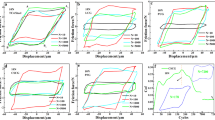Abstract
Serpentine is usually added into oil for tribological applications. To explore the performance and mechanism of serpentine, three different kinds of pins were tested under lubricated/dry sliding conditions. The result shows that a surface layer with an excellent anti-friction property was formed on the surface of worn steel. The binding ability between the matrix elements in the wear-induced transition zone and the unsaturated bonds released by serpentine is the key factor to form the anti-friction surface layer. Meanwhile, the hardness of the pairing material and frictional contact time determine the thickness and surface roughness of the anti-friction surface layer. In all, this work is hoped to be helpful in designing and researching a new industrial anti-friction material which can be used for dry sliding conditions.









Similar content being viewed by others
References
Cheng, T.W., Hsu, C.W.: A study of silicon carbide synthesis from waste serpentine. Chemosphere 64, 510–514 (2006)
Schulze, R.K., Hill, M.A., Field, R.D., Papin, P.A., Hanrahan, R.J., Byler, D.D.: Characterization of carbonated serpentine using XPS and TEM. Energy Convers. Manag. 45, 3169–3179 (2004)
Farhanga, F., Olivera, T.K., Raysonb, M., Brentb, G., Stockenhubera, M., Kennedy, E.: Experimental study on the precipitation of magnesite from thermally activated serpentine for CO2 sequestration. Chem. Eng. J. 1, 439–449 (2016)
Zhang, Q.W., Sugiyama, K., Saito, F.: Enhancement of acid extraction of magnesium and silicon from serpentine by mechanochemical treatment. Hydrometallurgy 45, 323–331 (1997)
Jin, Y.S., Li, S.H., Zhang, Z.Y., Yang, H., Wang, F.: In situ mechanochemical reconditioning of worn ferrous surfaces. Tribol. Int. 37, 561–567 (2004)
Higgs III, C.F., Wornyoh, E.Y.A.: An in situ mechanism for self-replenishing powder transfer films: experiment sand modeling. Wear 264, 131–138 (2008)
Zhao, F.Y., Kasrai, M., Sham, T.K., Bai, Z.M.: Characterization of tribofilms generated from serpentine and commercial oil using X-ray absorption spectroscopy. Tribol. Lett. 50, 287–297 (2013)
Pogodaev, L.I., Buynaovskii, I.A., Kryukov, E.Y.: The mechanism of interaction between natural laminar hydrosilicates and friction surfaces. J. Mach. Manuf. Reliab. 38, 476–484 (2009)
Yu, H.L., Xu, Y., Shi, P.J., Wang, H.M., Wei, M., Zhao, K.K., Xu, B.S.: Microstructure, mechanical properties and tribological behavior of tribofilm generated from natural serpentine mineral powders as lubricant additive. Wear 297, 802–810 (2013)
Wang, F.: Research on microstructure of the auto-restoration layer of worn surface of metals. Mater. Sci. Eng. A 399, 271–275 (2005)
Yu, H.L., Xu, Y., Shi, P.J.: Tribological behaviors of surfaced-coated serpentine ultrafine powders as lubricant additive. Tribol. Int. 43, 667–675 (2010)
Zhang, B.S., Xu, Y., Gao, F., Shi, P.J., Xu, B.S., Wu, Y.X.: Sliding friction and wear behaviors of surface-coated natural serpentine mineral powders as lubricant additive. Appl. Surf. Sci. 257, 2540–2549 (2011)
Wang, X., Wu, J.W., Wei, X.C., Liu, R.D., Cao, Q.: The effect of serpentine additive on energy-saving and auto-reconditioning surface layer formation. Ind. Lubr. Tribol. 69, 158–165 (2017)
Jin, K.J., Qiao, Z.H., Zhu, S.Y., Cheng, J., Yin, B., Yang, J.: Synthesis effects of Cr and Ag on the tribological properties of Cu–9Al–5Ni–4Fe–Mn bronze under seawater condition. Tribol. Int. 101, 69–80 (2016)
Zhang, B.S., Xu, B.S., Xu, Y., Gao, F., Shi, P.J., Wu, Y.X.: Cu nanoparticles effect on the tribological properties of hydrosilicate powders as lubricant additive for steel–steel contacts. Tribol. Int. 44, 866–878 (2011)
Almomani, M.A., Tayfour, W.R., Nimrat, M.H.: Effect of silicon carbide addition on the corrosion behavior of powder metallurgy Cu–30Zn brass in a 3.5 wt% NaCl solution. J. Alloys Compd. 679, 104–114 (2016)
Jia, Z.N., Yang, Y.L., Chen, J.J., Yu, X.J.: Influence of serpentine content on tribological behaviors of PTFE/serpentine composite under dry sliding condition. Wear 268, 996–1001 (2010)
Wang, X., Wei, X.C., Hong, X.L., Yang, J.Y., Wang, W.R.: Formation of sliding friction-induced deformation layer with nanocrystalline structure in T10 steel against 20CrMnTi steel. Appl. Surf. Sci. 280, 381–387 (2013)
Singh, J.B., Wen, J.G., Bellon, P.: Plastic strain-induced grain refinement in the nanometer scale in a Mg alloy. Acta Mater. 56, 3053–3064 (2008)
Meng-Burany, X., Perry, T.A., Sachdev, A.K., Alpas, A.T.: Subsurface sliding wear damage characterization in Al–Si alloys using focused ion beam and cross-sectional TEM techniques. Wear 207, 152–162 (2011)
Wei, X., Hua, M., Xue, Z., Gao, Z., Li, J.: Evolution of friction-induced microstructure of SUS 304 meta-stable austenitic stainless steel and its influence on wear behavior. Wear 267, 1386–1392 (2009)
Wang, X., Wei, X.C., Yang, X.R., Cheng, Z.B., Wang, W.R.: Atomic diffusion of gradient ultrafine structured surface layer produced by T10 steel rubbing against 20CrMnTi steel. Wear 304, 118–125 (2013)
Kalin, M.: Influence of flash temperatures on the tribological behaviour in low-speed sliding: a review. Mater. Sci. Eng. A 374, 390–397 (2004)
Qi, X.W., Jia, Z.N., Yang, Y.L., Fan, B.L.: Characterization and auto-restoration mechanism of nanoscale serpentine powder as lubricating oil additive under high temperature. Tribol. Int. 44, 805–810 (2011)
Yang, Y.L., Ma, J., Qi, X.W., Meng, X.S.: Fabrication of nano serpentine–potassium acetate intercalation compound and its effect as additive on tribological properties of the fabric self-lubricating liner. Wear 318, 202–211 (2014)
Lin, A., Takano, S., Hirono, T., Kanagawad, K.: Coseismic dehydration of serpentinite: evidence from high-velocity friction experiments. Chem. Geol. 344, 50–62 (2013)
Kim, D.J., Chung, H.S.: Synthesis and characterization of ZSM-5 zeolite from serpentine. Appl. Clay Sci. 24, 69–77 (2003)
Wang, X., Mao, D.D., Wei, X.C., Wang, W.R.: Cr atom diffusion in tribolayer T10 steel induced by dry sliding against 20CrMnTi steel. Appl. Surf. Sci. 270, 145–149 (2013)
Yua, T.H., Torresa, R., Merinovb, B.V., Goddardb, W.A.: Elucidating challenges of reactions with correlated reactant and product binding energies on an example of oxygen reduction reaction. J. Mol. Catal. A Chem. 423, 449–456 (2016)
Acknowledgements
This work was supported by the National Natural Science Foundation of China [Grant number 50975166, 51475280] and Excellent Engineer Training Program (Metallic material engineering of Shanghai University) of Ministry of Education, China.
Author information
Authors and Affiliations
Corresponding author
Rights and permissions
About this article
Cite this article
Wu, J., Wang, X., Zhou, L. et al. Formation Factors of the Surface Layer Generated from Serpentine as Lubricant Additive and Composite Reinforcement. Tribol Lett 65, 93 (2017). https://doi.org/10.1007/s11249-017-0873-1
Received:
Accepted:
Published:
DOI: https://doi.org/10.1007/s11249-017-0873-1




